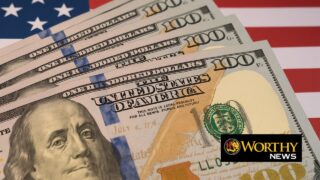Listeners:
Top listeners:
-
 play_arrow
play_arrow
U.S. Economy Surges in Second Quarter, Beating Expectations


by Emmitt Barry, with reporting from Washington D.C. Bureau Staff
WASHINGTON (Worthy News) = The U.S. economy grew at a faster pace than expected in the second quarter, fueled by stronger consumer spending and a steep drop in imports, according to the Commerce Department’s Bureau of Economic Analysis (BEA).
Gross domestic product (GDP) rose at an annualized 3.8 percent rate from April through June, a sharp upward revision from the initial 3 percent estimate and well above the 3.3 percent consensus forecast. The rebound followed a 0.6 percent contraction in the first quarter, which was revised lower from a 0.5 percent decline.
“GDP is growing at +3.8% in real terms, so despite the elevated inflation we have been living with since COVID, economic growth is exceeding that by a very large margin,” said Chris Zaccarelli, chief investment officer at Northlight Asset Management.
Consumers and Trade Drive Growth
Consumer spending, which accounts for more than two-thirds of U.S. economic activity, increased 2.5 percent in the second quarter–up from just 0.6 percent in the first quarter and far stronger than the earlier 1.6 percent estimate.
Imports fell by more than 29 percent, reversing a 38 percent spike in the first quarter when businesses rushed to stock up on foreign goods ahead of President Donald Trump’s new tariffs. Since GDP only counts domestic production, fewer imports boosted the second-quarter reading. Exports, however, slipped by 1.8 percent.
Government spending edged down for the second straight quarter, with federal expenditures dropping 5.3 percent. State and local government outlays rose by about 3 percent, partially offsetting the decline.
Private industries drove much of the growth, with real value added increasing by 10.2 percent in goods-producing sectors and 3.5 percent in services, more than compensating for a 3.2 percent decline in government output.
Inflation Cools, Jobs Mixed
Price pressures eased somewhat during the quarter. The GDP Price Index rose 2.1 percent, down from 3.6 percent in the prior quarter. Personal Consumption Expenditures (PCE) prices–a key Federal Reserve measure–also increased 2.1 percent, with core PCE inflation, excluding food and energy, running at 2.6 percent.
Labor market data painted a mixed picture. Initial jobless claims fell to 218,000 for the week ending Sept. 20, the lowest in two months, while continuing claims dropped to 1.93 million. Still, overall job growth remains subdued: the economy added just 22,000 new jobs in August, well below expectations.
Federal Reserve Chair Jerome Powell noted that slowing hiring was a key reason behind the Fed’s decision to cut interest rates at its September policy meeting. “They’ve kind of stopped hiring or slowed down their hiring, because they want to see how this all shakes out,” Powell said in remarks this week.
Outlook for the Second Half
Despite the strong rebound, economists warn that volatile trade flows and tariff-related uncertainty could dampen momentum in the second half of the year. Many expect growth to average closer to 1.5 percent for 2025 overall.
Still, the Atlanta Fed’s GDPNow model projects a 3.3 percent expansion in the third quarter, suggesting the economy may continue to outperform in the near term.
Durable goods orders, another key indicator, rose 2.9 percent in August–led by a surge in aircraft and defense equipment–after falling 2.7 percent in July. Excluding transportation, orders rose 0.4 percent.
The next major data point will be the August PCE Price Index, due this week, which will offer further clues on the path of inflation and the Fed’s policy decisions heading into year-end.
Copyright 1999-2025 Worthy News. This article was originally published on Worthy News and was reproduced with permission.
Latest News from Worthy News
Prime Minister Benjamin Netanyahu’s cabinet early Friday approved a U.S.-brokered ceasefire framework that aims to end active hostilities in Gaza and secure the release of all remaining Israeli hostages, despite unified opposition from far-right coalition partners.
A U.S. military team of 200 personnel will be deployed across the Middle East to help oversee the newly brokered Gaza ceasefire between Israel and Hamas, senior U.S. officials confirmed Thursday, marking the next phase of President Donald Trump’s Middle East peace initiative.
China has unveiled sweeping new export restrictions on rare-earth materials and related technologies — a move analysts describe as a near-unprecedented escalation in its economic confrontation with the United States. The rules, announced Thursday by China’s Commerce Ministry, could disrupt global supply chains for critical technologies, from semiconductors and solar panels to electric vehicles and advanced weapons systems.
Russian President Vladimir Putin has publicly admitted that Russian air defenses were responsible for downing an Azerbaijani passenger jet last December, killing 38 people, in what analysts say marks a stunning acknowledgment that further erodes Moscow’s standing among former Soviet republics.
U.S. President Donald J. Trump confirmed Thursday that he will visit Israel to meet Prime Minister Benjamin Netanyahu and deliver a major address to the Knesset, Israel’s parliament, amid rising hopes that his proposed ceasefire plan could end the devastating war with Hamas and bring peace to the Jewish nation and the region.
Hamas declared the end of more than two years of war between Israel and the Islamist group after both sides signed a U.S.-brokered ceasefire deal aimed at establishing a permanent halt to hostilities in Gaza.
With a notoriously cold winter approaching, Russia has launched a major campaign to deny Ukraine heat, light, and running water, authorities said Wednesday.

WHO WE ARE
The Psalms, hymns, and spiritual songs encapsulate the beauty, wisdom, and eternal truths found in the Bible, creating an immersive experience that resonates with believers and seekers alike.
CONTACT
- +1 908 280-4246
- Essex County, USA
- info@tnjrfm.com
Copyright The New Jerusalem Media.









